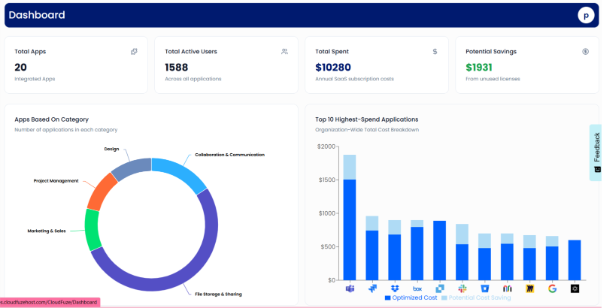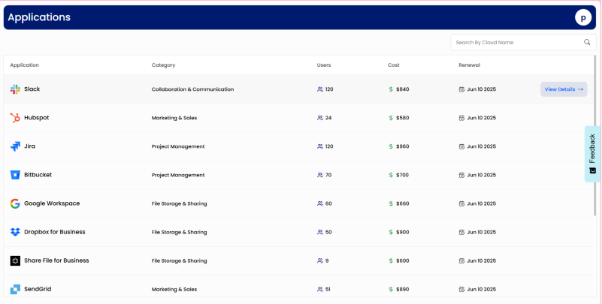How can SaaS Management Help IT Managers?

As an IT manager, you are responsible for managing user access, optimizing costs, ensuring security, and keeping your tech stack running smoothly. With the growth of cloud-based tools, managing everything manually can become even more tedious.
That’s where our leading SaaS management software, CloudFuze Manage, comes in. At CloudFuze, we offer a SaaS management solution to manage all your organization’s tools without any hassle.
In this blog post, you’ll learn what SaaS management is, why it matters, the challenges it helps you overcome, and how our SaaS management solution can help you govern all your software systems.
What is SaaS Management and Why is it Essential for IT?
SaaS management is the process you use to manage, discover, secure, and optimize all the SaaS applications your organization uses. It gives you visibility into who’s using what, how often, and at what cost. With a SaaS management service, you can track licenses, monitor usage, enforce security policies, and ensure compliance, all from a centralized platform.
Why SaaS Management Matters for Your Business?
You know how quickly SaaS tools can multiply across departments. Marketing uses one CRM, sales use another, and HR might have their own onboarding platform. Without a clear system to manage SaaS applications, you’ll face:
- Shadow IT
Employees sign up for tools without your knowledge, creating security and compliance risks.
- Wasted License Spend
You pay for tools that no one uses that inflate your IT budget unnecessarily.
- SaaS breaches
Disconnected apps lead to fragmented data and poor collaboration.
- Security Gaps
Unmonitored apps become potential entry points for SaaS security threats.
That’s why you need a way to manage SaaS applications efficiently, without slowing down innovation.
How SaaS Management Helps You as an IT Manager
As an IT manager in your organization, you can manage your SaaS stack effortlessly with SaaS management apps. Here are its benefits:
1. Increased Visibility of SaaS Stack
You can’t manage what you can’t see. A SaaS management system gives you a real-time view of every SaaS app in use across your organization. You can see:
- Who’s using each app
- How often do they use it
- What it costs
2. Management of License & Budgets
With SaaS management, you stop wasting money on tools no one uses. Also:
- You can directly monitor license utilization
- Cancel hidden subscription costs
- Also, you can consolidate overlapping tools
3. Powerful Security and Data Compliance
Security is one of your top priorities. A SaaS management service helps:
- To detect unauthorized apps (shadow IT)
- Enforce access controls, compliance (like GDPR or SOC 2 Type 2), and permissions
- To monitor for risky behaviour or data leaks
4. Simplify Onboarding and Offboarding
When new employees join, you want them to get access to all relevant tools. But when they leave, you need to revoke access immediately. With SaaS management
- You can automatically assign tools during onboarding
- Instantly deprovision users during offboarding
- Also, you can maintain audit trails for accountability
5. Improved Employee Collaboration Across Departments
With SaaS management, you can collaborate with your organization’s department heads to:
- Evaluate tool effectiveness and align software usage with your business goals
- Support digital transformation initiatives
SaaS Management Challenges
Managing SaaS applications isn’t always easy. You’ll likely face these common challenges:
- You may not know all the tools employees are using.
- Connecting various tools and data sources can be complex.
- It takes time to get teams to adopt new processes.
- As your company grows, your SaaS stack also increases, which makes managing it difficult.
Take Control of Your SaaS Stack with CloudFuze Manage
Our proven SaaS management platform , CloudFuze Manage, helps IT managers with solutions to manage your organization’s SaaS applications securely and cost-effectively.
- Connect all your apps instantly – You can connect every SaaS tool with one click and uncover Shadow IT effortlessly.

- Cut costs by 20–30% – You can easily identify unused subscriptions and eliminate hidden expenses.
- Manage licenses in one place – You can track licenses, renewals, usage, and costs from a single dashboard.

- Zero touch onboarding & offboarding – You may be able to save 5–10 hours per employee per month by automating onboarding and offboarding.
- Enforce security policies – You can control access and protect sensitive data across all applications.
- Stay ahead of renewals – You receive timely alerts and avoid missed deadlines.
- Make wise decisions – You can use real-time reports to guide SaaS budgeting, license optimization, and strategic planning.
The Future of SaaS Management
As SaaS adoption continues to grow, you’ll see new trends shaping the future of SaaS management:
- AI Insights to predict usage trends and optimize spend automatically.
- Zero Trust Security will enforce strict access controls across all apps.
- Governance Frameworks to standardize how your organization evaluates, approves, and manages SaaS tools.
Final Thoughts
With an efficient SaaS management platform, IT managers can finally abandon their traditional manual tasks. At CloudFuze, we offer a SaaS management solution that eases your app discovery, license management, and business workflow automation. Take charge with our SaaS management service that empowers you to manage smarter, not harder.
Don’t let your SaaS stack spiral out of control. Contact us now for a FREE demo today!
FAQs
1. What are SaaS license management tools?
SaaS license management tools are the tools that track, control, and optimize all your software subscriptions. These tools help you avoid overspending, comply with vendor agreements, and eliminate unused or duplicate licenses.
2. What are the four tenets of SaaS management?
When managing SaaS tools, IT teams should focus on four key areas:
- Complete visibility into all SaaS apps in use.
- Optimize licenses to match actual usage.
- Reduce costs by eliminating unused apps.
- Minimize risk by enforcing security and compliance policies.
3. Can CloudFuze Manage handle 25+ SaaS tools at once?
Yes. You can manage 25 or more SaaS applications with CloudFuze Manage. Our SaaS management platform scales with your needs, giving you centralized control, automation, and insights across all your tools.



Leave A Comment